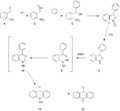Lehmstedt–Tanasescu reaction
Lehmstedt–Tanasescu reaction is a chemical reaction named after the scientists who first described it, Lehmstedt and Tanasescu. This reaction involves the transformation of certain organic compounds through a specific process, which has implications in the field of organic chemistry and medicinal chemistry. The Lehmstedt–Tanasescu reaction is particularly noted for its application in the synthesis of complex molecules, which can be used in the development of pharmaceuticals and other chemical products.
Overview[edit]
The Lehmstedt–Tanasescu reaction is a type of organic reaction that enables the formation of complex molecular structures from simpler organic compounds. This reaction is characterized by its specificity and the conditions under which it occurs, often requiring the presence of a catalyst or specific environmental conditions such as temperature and pressure. The products of the Lehmstedt–Tanasescu reaction are of significant interest in various fields, including drug development and materials science, due to their potential applications.
Mechanism[edit]
The mechanism of the Lehmstedt–Tanasescu reaction involves several key steps, starting with the activation of the starting material, followed by a series of transformations that lead to the formation of the final product. The specific details of the mechanism can vary depending on the substrates and conditions used, but generally involve nucleophilic or electrophilic attack, rearrangement, and bond formation processes. Understanding the mechanism is crucial for optimizing the reaction conditions and achieving high yields of the desired product.
Applications[edit]
The applications of the Lehmstedt–Tanasescu reaction are wide-ranging, with particular importance in the synthesis of pharmaceuticals. The ability to construct complex molecules from simpler precursors makes this reaction a valuable tool in the development of new drugs, especially those with challenging molecular architectures. Additionally, the reaction finds use in the synthesis of materials with unique properties, contributing to advances in materials science and engineering.
Challenges and Future Directions[edit]
Despite its utility, the Lehmstedt–Tanasescu reaction faces challenges, such as the need for stringent reaction conditions and the potential for unwanted side reactions. Research in this area continues to focus on improving the efficiency and selectivity of the reaction, as well as expanding its applicability to a broader range of substrates. Future developments may include the discovery of new catalysts, the development of greener reaction conditions, and the application of this reaction in the synthesis of novel compounds with significant biological or material properties.
See Also[edit]
-
Lehmtan1
-
Lehmtan2
Ad. Transform your life with W8MD's Budget GLP-1 injections from $75


W8MD offers a medical weight loss program to lose weight in Philadelphia. Our physician-supervised medical weight loss provides:
- Weight loss injections in NYC (generic and brand names):
- Zepbound / Mounjaro, Wegovy / Ozempic, Saxenda
- Most insurances accepted or discounted self-pay rates. We will obtain insurance prior authorizations if needed.
- Generic GLP1 weight loss injections from $75 for the starting dose.
- Also offer prescription weight loss medications including Phentermine, Qsymia, Diethylpropion, Contrave etc.
NYC weight loss doctor appointmentsNYC weight loss doctor appointments
Start your NYC weight loss journey today at our NYC medical weight loss and Philadelphia medical weight loss clinics.
- Call 718-946-5500 to lose weight in NYC or for medical weight loss in Philadelphia 215-676-2334.
- Tags:NYC medical weight loss, Philadelphia lose weight Zepbound NYC, Budget GLP1 weight loss injections, Wegovy Philadelphia, Wegovy NYC, Philadelphia medical weight loss, Brookly weight loss and Wegovy NYC
|
WikiMD's Wellness Encyclopedia |
| Let Food Be Thy Medicine Medicine Thy Food - Hippocrates |
Medical Disclaimer: WikiMD is not a substitute for professional medical advice. The information on WikiMD is provided as an information resource only, may be incorrect, outdated or misleading, and is not to be used or relied on for any diagnostic or treatment purposes. Please consult your health care provider before making any healthcare decisions or for guidance about a specific medical condition. WikiMD expressly disclaims responsibility, and shall have no liability, for any damages, loss, injury, or liability whatsoever suffered as a result of your reliance on the information contained in this site. By visiting this site you agree to the foregoing terms and conditions, which may from time to time be changed or supplemented by WikiMD. If you do not agree to the foregoing terms and conditions, you should not enter or use this site. See full disclaimer.
Credits:Most images are courtesy of Wikimedia commons, and templates, categories Wikipedia, licensed under CC BY SA or similar.
Translate this page: - East Asian
中文,
日本,
한국어,
South Asian
हिन्दी,
தமிழ்,
తెలుగు,
Urdu,
ಕನ್ನಡ,
Southeast Asian
Indonesian,
Vietnamese,
Thai,
မြန်မာဘာသာ,
বাংলা
European
español,
Deutsch,
français,
Greek,
português do Brasil,
polski,
română,
русский,
Nederlands,
norsk,
svenska,
suomi,
Italian
Middle Eastern & African
عربى,
Turkish,
Persian,
Hebrew,
Afrikaans,
isiZulu,
Kiswahili,
Other
Bulgarian,
Hungarian,
Czech,
Swedish,
മലയാളം,
मराठी,
ਪੰਜਾਬੀ,
ગુજરાતી,
Portuguese,
Ukrainian
